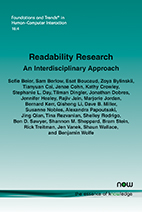Readability Research: An Interdisciplinary Approach
By Sofie Beier, Centre for Visibility Design, Royal Danish Academy, Denmark | Sam Berlow, Typography for Good, USA | Esat Boucaud, The Readability Consortium, University of Central Florida, USA | Zoya Bylinskii, Adobe Inc., San Francisco, USA, bylinski@adobe.com | Tianyuan Cai, Adobe Inc., San Francisco, USA | Jenae Cohn, California State University, USA | Kathy Crowley, Readability Matters, USA | Stephanie L. Day, The Readability Consortium, University of Central Florida, USA | Tilman Dingler, University of Melbourne, Australia | Jonathan Dobres, Sonos, Inc., USA | Jennifer Healey, Adobe Inc., San Francisco, USA | Rajiv Jain, Adobe Inc., San Francisco, USA | Marjorie Jordan, Readability Matters, USA | Bernard Kerr, Adobe Inc., San Francisco, USA | Qisheng Li, Paul G. Allen School of Computer Science and Engineering, University of Washington, USA | Dave B. Miller, Tufts University, USA | Susanne Nobles, ReadWorks, USA | Alexandra Papoutsaki, Department of Computer Science, Pomona College, USA | Jing Qian, Brown University, USA | Tina Rezvanian, Adobe Inc., San Francisco, USA | Shelley Rodrigo, University of Arizona, USA | Ben D. Sawyer, The Readability Consortium, University of Central Florida, USA, sawyer@inhumanfactors.com | Shannon M. Sheppard, Chapman University, Department of Communication Sciences and Disorders, USA | Bram Stein, The Type Founders, USA | Rick Treitman, Adobe Inc., San Francisco, USA | Jen Vanek, World Education, Digital Learning and Research, USA | Shaun Wallace, Brown University, USA | Benjamin Wolfe, University of Toronto Mississauga, Canada
Abstract
The control provided by digital displays over how visual information is presented to readers has the potential to improve reading for each and every reader, regardless of ability or diagnosis. On screens, text is fluid, allowing for individual customization based on reader needs, content, and reading task. This represents a profound shift in how we think about reading, because text is no longer rendered immutable by writers, designers or publishers at a single stage, and human-computer interaction research is key to realizing its potential. Targeted changes to the visual characteristics of text on screens increases the ease with which a reader can process and derive meaning. In this review, we provide a comprehensive introduction to interdisciplinary methodologies, tools, and materials required for readability research focused on the individual reader. We call on the HCI community to contribute to our growing understanding of readers’ needs, to study the interactions between text, user, and task, and to build the tools and interfaces needed to improve reading outcomes for all.
Readability Research: An Interdisciplinary Approach
From the moment we wake up to the moment we end our day, we use interfaces built out of the written word. Textual information remains now, as it has for centuries, the cornerstone of human information acquisition. The wide adoption of smartphone, tablets, e-readers and personal computers has shifted the bulk of this reading from inflexible paper to digital content. The control provided by digital displays over how visual information is presented to readers has the potential to improve reading for each and every reader, regardless of ability or diagnosis. This represents a profound shift in how we think about reading because text is no longer rendered immutable by writers, designers, or publishers at a single stage, and human-computer interaction research is key to realizing its potential.
Readability research takes a fundamentally individual approach to what each reader needs. Each reader has their own individual needs. Meanwhile, adapting the written word to the individual reader has never been easier, and the goal of maximizing individual reading efficacy is increasingly attainable. No one discipline or field has all the tools or answers, and readability work is inherently interdisciplinary. The authors of this monograph include vision scientists, technology experts, educators, designers, typographers, and data scientists. Together they represent voices from academia, the tech industry, and non-profit institutions, driven by common goals to improve the reading interfaces of today. In this review, they provide a comprehensive introduction to interdisciplinary methodologies, tools, and materials required for readability research focused on the individual reader. They call on the HCI community to contribute to the growing understanding of readers’ needs; to study the interactions between text, user, and task; and to build the tools and interfaces needed to improve reading outcomes for all.
